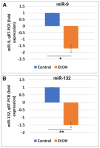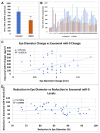Fetal Brain-Derived Exosomal miRNAs from Maternal Blood: Potential Diagnostic Biomarkers for Fetal Alcohol Spectrum Disorders (FASDs)
- PMID: 38892014
- PMCID: PMC11172088
- DOI: 10.3390/ijms25115826
Fetal Brain-Derived Exosomal miRNAs from Maternal Blood: Potential Diagnostic Biomarkers for Fetal Alcohol Spectrum Disorders (FASDs)
Abstract
Fetal alcohol spectrum disorders (FASDs) are leading causes of neurodevelopmental disability but cannot be diagnosed early in utero. Because several microRNAs (miRNAs) are implicated in other neurological and neurodevelopmental disorders, the effects of EtOH exposure on the expression of these miRNAs and their target genes and pathways were assessed. In women who drank alcohol (EtOH) during pregnancy and non-drinking controls, matched individually for fetal sex and gestational age, the levels of miRNAs in fetal brain-derived exosomes (FB-Es) isolated from the mothers' serum correlated well with the contents of the corresponding fetal brain tissues obtained after voluntary pregnancy termination. In six EtOH-exposed cases and six matched controls, the levels of fetal brain and maternal serum miRNAs were quantified on the array by qRT-PCR. In FB-Es from 10 EtOH-exposed cases and 10 controls, selected miRNAs were quantified by ddPCR. Protein levels were quantified by ELISA. There were significant EtOH-associated reductions in the expression of several miRNAs, including miR-9 and its downstream neuronal targets BDNF, REST, Synapsin, and Sonic hedgehog. In 20 paired cases, reductions in FB-E miR-9 levels correlated strongly with reductions in fetal eye diameter, a prominent feature of FASDs. Thus, FB-E miR-9 levels might serve as a biomarker to predict FASDs in at-risk fetuses.
Keywords: brain development; exosomes; fetal alcohol syndrome; fetal eye; miR-9.
Conflict of interest statement
The authors declare no conflict of interest.
Figures







Similar articles
-
Prenatal Alcohol Exposure Inhibits Transient Expression of Autophagy and Synaptic Proteins in Developing Brain.Obstet Gynecol Res. 2025;8(1):10-24. doi: 10.26502/ogr0173. Epub 2025 Jan 22. Obstet Gynecol Res. 2025. PMID: 40084086 Free PMC article.
-
Biomarkers of Affective Dysregulation Associated with In Utero Exposure to EtOH.Cells. 2023 Dec 19;13(1):2. doi: 10.3390/cells13010002. Cells. 2023. PMID: 38201206 Free PMC article.
-
Effects of In Utero EtOH Exposure on 18S Ribosomal RNA Processing: Contribution to Fetal Alcohol Spectrum Disorder.Int J Mol Sci. 2023 Sep 5;24(18):13714. doi: 10.3390/ijms241813714. Int J Mol Sci. 2023. PMID: 37762017 Free PMC article.
-
Nonprotein-coding RNAs in Fetal Alcohol Spectrum Disorders.Prog Mol Biol Transl Sci. 2018;157:299-342. doi: 10.1016/bs.pmbts.2017.11.024. Epub 2018 Apr 12. Prog Mol Biol Transl Sci. 2018. PMID: 29933954 Review.
-
Fetal Cerebral Artery Mitochondrion as Target of Prenatal Alcohol Exposure.Int J Environ Res Public Health. 2019 May 7;16(9):1586. doi: 10.3390/ijerph16091586. Int J Environ Res Public Health. 2019. PMID: 31067632 Free PMC article. Review.
Cited by
-
Prenatal Alcohol Exposure Inhibits Transient Expression of Autophagy and Synaptic Proteins in Developing Brain.Obstet Gynecol Res. 2025;8(1):10-24. doi: 10.26502/ogr0173. Epub 2025 Jan 22. Obstet Gynecol Res. 2025. PMID: 40084086 Free PMC article.
References
-
- Hoyme H.E., Kalberg W.O., Elliott A.J., Blankenship J., Buckley D., Marais A.S., Manning M.A., Robinson L.K., Adam M.P., Abdul-Rahman O., et al. Updated Clinical Guidelines for Diagnosing Fetal Alcohol Spectrum Disorders. Pediatrics. 2016;138:e20154256. doi: 10.1542/peds.2015-4256. - DOI - PMC - PubMed
-
- Balaraman S., Schafer J.J., Tseng A.M., Wertelecki W., Yevtushok L., Zymak-Zakutnya N., Chambers C.D., Miranda R.C. Plasma miRNA Profiles in Pregnant Women Predict Infant Out- 946 comes following Prenatal Alcohol Exposure. PLoS ONE. 2016;11:e0165081. doi: 10.1371/journal.pone.0165081. - DOI - PMC - PubMed
MeSH terms
Substances
Grants and funding
LinkOut - more resources
Full Text Sources
Medical

